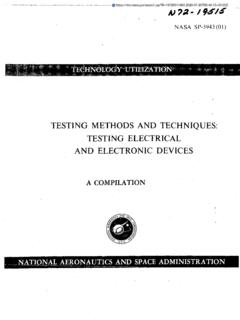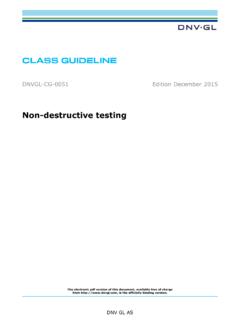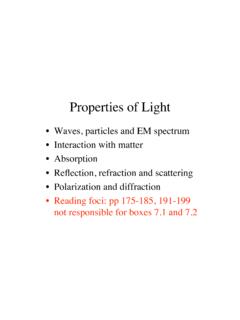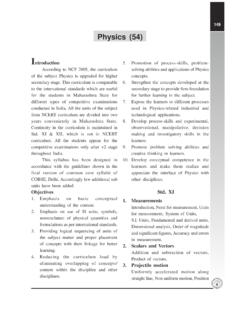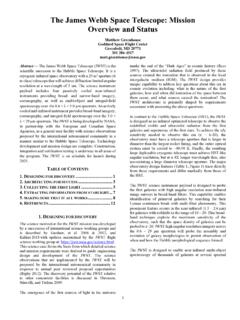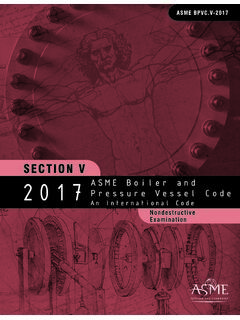Transcription of The James Webb Space Telescope: Mission Overview and Status
1 The James Webb Space Telescope: Mission Overview andStatusMatthew Greenhouse and The JWST Science Working Group'Abstract The James Webb Space Telescope (JWST) is the infrared successor to the Hubble SpaceTelescope. It is a cryogenic infrared Space observatory with a 25 m' aperture (6 in telescopeyielding diffraction limited angular resolution at a wavelength of 2 um. The science instrument payloadincludes three passively cooled near-infrared instruments providing broad- and narrow-band imagery,coronagraphy, as well as multi object and integral-field spectroscopy over the < 0 < Dm spectrum. An actively cooled mid-infrared instrument provides broad-band imagery, coronagraphy, andintegral-field spectroscopy over the < 0 < 29 Om spectrum. The JWST is being developed by NASA,in partnership with the European and Canadian Space Agencies, as a general user facility with scienceobservations to be proposed by the international astronomical community in a manner similar to theHubble Space Telescope.)
2 Technology development and Mission design are complete, and constructionis underway in all areas of the program. The JWST is oil to reach launch readiness Designing for DiscoveryThe science motivation for the JWST Mission was developed by a succession of internationalscience working groups and is described by Gardner et al. 2006, with updates maintained by the JWST flight science working group' at: jwst/science/whitepapers/ . This science caseforms the basis from which detailed science and Mission requirements were derived to guide engineer-in g design and development of the JWST as a research tool. The science observations that are actuallyimplemented by the JWST will be proposed by the international astronomical conuuunity in responseto annual peer reviewed proposal opportunities. The discovery potential of the JWST relative to otherconcurrent facilities is discussed in Thronson, Stiavelli, and Tielens emergence of the first sources of light in the universe (after decoupling) marks the end of the"Dark Ages" in cosmic history (Rees 1997).
3 The ultraviolet radiation field produced by these sourcescreated the ionization that is observed in the local intergalactic medium (IGM). The JWST desig n pro-vides unique capability to address key questions about this era in cosmic evolution including: what isthe nature of the first galaxies; how and when did ionization of the Space between them occur; andwhat sources caused the ionization'.'The JWST architecture is primarily shaped by requirements associated with answering the abovequestions. In contrast to the Hubble Space Telescope (HST), the JWST is designed as all opti-mized telescope to observe the red shifted ultraviolet radiation from the first galaxies and supernovaeof the first stars. To achieve the rely sensitivity needed to observe this era (z 6-20), the observatorymust have a telescope aperture that is larger in diameter than the largest rocket faring, and the entireoptical system must be cooled to 40-50K.
4 Finally, the resulting large deployable cryogenic telescopemust achieve HST-like angular resolution across the SWIR spectrum. The major observatory designfeatures seen in Figure 1 trace directly from these requirements and differ markedly from those of theHST (Table 1).'John C. Mather, Mark Clainpin, Rene Doyon, Kathryn A. Flanagan, Marijn Franx, Matthew , Heidi B. Hannmel, John B. Hutchings, Peter Jakobsen, Simon J. Lilly, Jonathan I. Lupine,Mark J. McCaughrean, Matt Mountain, George H. Rieke, Marcia J. Rieke, George Sonneborn, Massi-mo Stiavelli, Rogier Windhorst and Gillian S. ParameterHSTJWSTOTE Diameter (meters) by (kg)116006330 Output Power at Load Input (watts)24002079 Unobscured Aperture (Sq meters) Optical Transmission45 to 25%62% to 43%Telescope Field of View (Arcmin) (Radius)18 by 9 Wavelength of diffraction Limited Performance (Microns) Radius (Aresec) Strehl Ratio80%80%Pointing Accuracywithout Fine Guidance (Aresec)227 Pointing Stability with Fine Guidance (Aresec) Pixels (Megapixels)2560 Data Throughput (Gbits/day)27471lObservin,q Efficiency50%70%Table 1: Key design parameters of the JWST and HSTF igure 1: Full scale display model of the JWST Space vehicleThe JWST science instrument payload is designed to probe the first galaxies with high angular resolu-tion near-infrared image surveys ill filters.
5 This capability enables identification of primev-al galaxies by searching their Lyman continuum break with multi-filter photometry. This prominentfeature occurs ill near-infrared ( um) for galaxies with redshifts in the range of 10 broad-baud technique exploits the maximum sensitivity of the observatory, such that the spacedensity of galaxies call probed to z-20. JWST high angular resolution imagery across the 29um spectrum will probe the assembly and evolution of galaxy morphologies to enable observation ofwhen and how the Hubble sequence 2: The JWST will orbit the Sun-Earth JWST is designed to enable near-infrared nnulti-object spectroscopy of thousands of galaxies atseveral spectral resolutions (_102, _101). This capability will probe the chemical evolution and metal-licity of galaxies, and the ionization state of the IGM across cosmic time.
6 Low resolution multi-objectspectroscopy will enable calibration of photometric redshifts for primeval galaxy studies. The JWST spectrometers include integral field capability over the 29 um spectrum that will enable detailedspectral, morphological, and kinematic studies of high redshift galaxies and local g alaxy nuclei. JWST spectroscopy includes wide field scanning Fabry-Perot and narrow-band filter imagery at low (-1%)spectral resolution and high angular resolution to enable both wide field emission line imagery andhigh redshift surveys of emission line JWST observatory design enables wide discovery potential beyond cosmology and galaxy stu-dies. The JWST high angular resolution imagery and imaging spectroscopy across the 29 umspectrum will open a new window oil of star formation in our own galaxy to reveal: howmolecular clouds collapse; how enviromuent effects star formiation and vice-versa, the mass distribu-tion of low mass stars; and the relationship be-tween stellar debris disks the formation of ter-restrial planets.
7 M'^^The JWST instruments include corona-graphic imagery and spectroscopy capabilitythat will enable a wide range of stellar debrisdisk studies and extra-solar planet observationsat high angular resolution. High dynamic rangemodes of the JWST instruments will enableextra-solar planet transit photometry and spec-troscopy across the above wavelength JWST observatory enables non-siderealtracking so that the full observatory capabilitycall used observe the outer solar system toenable comparative studies between stellar de-bris disks and our own solar Architecting for successThe large primary mirror area and cryogenic operating temperature are key drivers on the JWST Mission architecture. The telescope is the largest Space telescope ever constructed. Liquid cryogencooling techniques used by prior infrared Space observatories (IRAS, ISO, Spitzer) cannot be practical-ly scaled to meet JWST requirements, and existing cryo-cooler technology could not meet the heat liftrequirements of this large system.
8 As a consequence, a passively cooled architecture was adopted forthe majority of the system. A libration point orbit about the Sum-Earth L2 point (Figure 2) was selectedto meet this requirement. In this orbit, the observatory follows the earth around the sun such that thesun and earth always appear in the same direction. Hence, it is possible to continuously shield portionsof the observatory from the sun and earth to enable passive cryogenic cooling. The orbit about the L2point itself is sized to avoid eclipses; thus enabling continuous generation of power with solar orbit has a period of approximately 6 months and is unstable requiring use of station keepingthrusters. Propellant for orbit maintenance and momentum management ultimately limits the lifetime ofthe observatory to approximately twice the duration of its 5 year science JWST call the whole sky while remaining continuously in the shadow of its sun shown in Figure 3, the Space vehicle call through all of 50 degrees and rotate completelyabout the earth-sun line to observe sources within an annulus that covers approximately 39% of thesky.
9 As the observatory orbits the sun, this annulus sweeps over the whole sky each year with smallcontinuous viewing zones at the ecliptic ConfiquiationNMI m4A72 JWST call this orbit inapproximately 100 days after launchfrom Kourou Launch Center inFrench Guiana using all 5 ECA launch vehicle via a directtransfer trajectory. This class oflaunch vehicle provides adequatefairing volume and mass capabilityto enable an observatory design thatmeets the above science require- Townmeats. the&The in telescope andits tennis court sized sunshield, aredesigned to be stowed within theArian 5 in faring alongwith the science instrument payload and spacecraft (Figures 4, 5) such - _____ Continuous that the observatory can deploy into ZoneSoud,the operational configuration shown Figure 3: The JWST can observe the whole sky while re- in Figure 1 (see animation at: maining in the shadow of its , ).
10 The observatory is launched warn and cooling begins after sunshield deployment in route to theL2 4: The JWST is the largest cryogenic optical system ever constructed5 Figure 5: The JWST is designed to integrate with an Arian 5m diameter faringThe resulting Mission architecture is shown in Figure 6. During operations, the NASA Deep SpaceNetwork is used to support two 4 hr communications contacts each day during which approximately470 Gbits of science and engineering data are downloaded. Both Mission and science operations aresupported by the Space Telescope Science Institute. Overall Mission management, as well as guidancenavigation and control, are provided by Goddard Space Flight Coverage ProvidedFor all Critical EventsObservatory DeploymentsSolar Array-High Gainl Medium AntennasAriane5 Upper Observatory - Upper Stage SunshieldStage Injects JWST Separation -Optical Telescope ElementInto Direct Transfer =Trajectory _.

